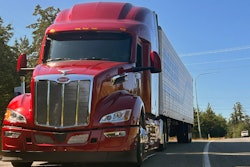
About six years ago, I first laid eyes on an oddly shaped semi truck that looked like it just rolled out of Detroit Auto Show and into an episode of The Jetsons. But, shaped more like an intercontinental ballistic missile than an International conventional (it's built on an International chassis), Shell's Starship posted some then-eye popping freight efficiency numbers.
In 2018, 8.94 mpg was massive. It's not unheard of today for professional drivers to routinely top 9 mpg, or even 10 mpg, but Starship back then set the deck for what was possible. It also achieved a freight ton efficiency average of 178.4 ton-miles per gallon, a 248% improvement over the on-highway Class 8 industry average of 72 ton-mpg. That's still pretty staggering.
Shell's Starship is currently in its third generation, and a new feature in this variant is a Cummins X15N natural gas engine. The previous iterations had been exclusively diesel-powered.
 Starship's carbon fiber cab was designed to be lightweight with low aerodynamic drag.
Starship's carbon fiber cab was designed to be lightweight with low aerodynamic drag.
Heather Duffey, global integrated communications manager for Shell Commercial Road Transport Lubricants, said, for this third iteration, Shell wanted to focus on cleaner emissions and alternative fuels, but it was important that infrastructure was readily available to support it. Hydrogen got brief consideration, but natural gas quickly became the obvious choice because, "it's something that fleets can adopt now," she said, adding that Starship was born from the idea that it would serve "as test dummy for fleets to see what is possible today with readily available technology."
While it is important that Starship include technology and solutions available today, Duffey noted that the truck indeed is "a lab on wheels" used to validate and prove a variety of things, like the effectiveness of lower viscosity oils and lubricants on alternative fuel powertrains.
The truck uses Shell Rotella NG Plus SAE 5W-30 FA-4 synthetic engine oil, a low-viscosity oil that reduces flow resistance and friction, leading to better fuel economy without compromising protection and efficiency, and Shell Spirax S6 GME 40 in its automated manual Eaton transmission, a synthetic lubricant specifically formulated to protect high-torque transmissions paired with increased horsepower engines. By demoing these lighter-weight fluids, Shell is giving fleets notice that its is putting their money where their mouth is.
“[Fleets] are not going to run out and buy something new," Duffey said. "They’re going to want to see that it works," and aside from the uniquely designed and customized cab, "everything else is something a fleet can add to their own trucks," Duffey said.
 The cockpit maintains the aircraft feel with multiple screens and a blend of digital and analog gauges.
The cockpit maintains the aircraft feel with multiple screens and a blend of digital and analog gauges.
Star-studded impression
The first thing you notice is obviously the bullet-shaped nose. It's not changed since the first generation but it would be irresponsible to not mention it. It's not everyday you see a carbon fiber cab, much less one shaped like Jimmy Durante's snoot.
The climb inside the tractor is like boarding a Gulfstream. An actuated door with integral steps lowers itself to greet the driver and closes snugly behind you. No three points of contact here. When you step inside, you're behind the passenger seat. There are no conventional doors and the passenger side clamshell airstair is the only way to get inside.
There's tons of headroom and space in general but there's no sleeper or driver amenities. In the bunk area you'll find a bench-style seat with a lot of leg and headroom.
The cockpit maintains the aircraft feel with multiple screens that serve various purposes, from monitoring the truck's conditions to serving as its mirrors, both side and rear-view. The deep wrap-around dash feels like you're wearing the truck like a belt.
The view from the cab is panoramic thanks to the fishbowl layout of the massive windshield and huge windows that are unobstructed by side mirrors. Those have been replaced by a camera system for improved visibility and better aerodynamics. It's pretty remarkable to think that a mirror camera system is probably the most mundane technology on this truck, but that's a testament to how forward-thinking this rig is.
 The view from the cab is panoramic.
The view from the cab is panoramic.
Star power
The biggest compliment I could give an alternative fuel solution is that it doesn't really feel all that alternative. The X15N makes good power and it sounds like you'd want it to sound. I took a very lightly-loaded trailer around Barber Motorsports Park, located in the suburbs of Birmingham, Alabama, for three short laps, so I can't testify to the raw power that was at my disposal.
This was my second crack at the Cummins 15-liter nat gas engine, but my first trip in Starship's driver's seat.
I spent some time talking with brothers Brian and Eric Rector who, as Starship co-pilots, have logged countless hours and thousands of miles in the cab. Last year, they took Shell Starship 3.0, loaded with Shell Rotella engine oil, on an 840-mile loop throughout California, collecting performance data. Eric told me he's never noticed any meaningful difference between the natural gas power and its diesel equivalent. He's a career trucker, so I'll take his word for it.
The ability to run on renewable natural gas (RNG) provides a significant advantage in terms of emissions reduction. RNG is a low-carbon transportation fuel derived from organic waste, which can be used interchangeably with Compressed Natural Gas (CNG) and Liquid Natural Gas (LNG) in transport vehicles. RNG isn't always easy to find, so CNG is a viable alternative.
Shooting star
Why natural gas (and renewable diesel, for that matter) doesn't get the same legislative attention that battery electric does is beyond me, because real-world business cases already exist for many trucking applications.
Shell's demo tractor is out on the highway doing the unsexy heavy lifting; showing fleets and lawmakers what is possible in between the diesel-or-die holdouts and the all-electric, all-the-time mandates. There are a number of viable, stop-gap, lower emissions solutions that won't bankrupt a motor carrier or rip a hole in the ozone, and natural gas is certainly one of the more ready for primetime solutions in that space. In the meantime, especially in the current suppressed freight environment, efficiency is the pathway to stay in business, and Starship is proving that, too.











